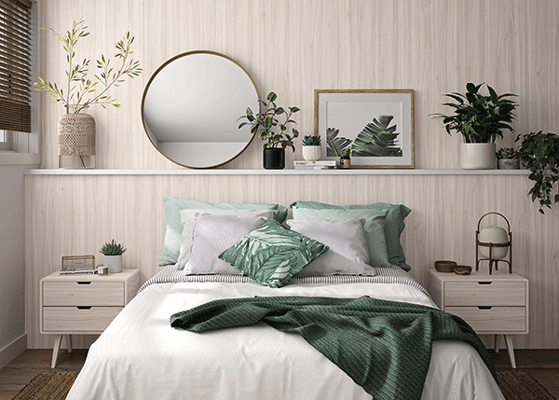The so called “pandemic fatigue” is one of the biggest challenges we face in this new era. According to the latest studies, the Covid-19 crisis has negatively affected people’s mental health, increasing pathologies such as anxiety, depressive disorders and sleeping issues.
As a result, now more actively than ever, consumers prioritise cosy environments that make them feel safe and protected.
To achieve this, it is vital to choose the appropriate materials, as both the touch and the visual impact of the surfaces is what link different decorative elements and provide harmony to the room.
That is why in the upcoming months, within the majority of styles, new common trends will emerge:
- Wood as the main element.
- Combination of materials.
- Connection to nature.
Wood as the main element
It is not by chance that this material is more and more present everywhere in the house, from dining rooms to bedrooms and bathrooms or kitchens. In fact, wood is the basis from which almost every decorative style starts to build a cosy space.
In this way, used old woods with natural imperfections and reused elements generate a feeling of nostalgia that triggers a cosy feeling.
Meanwhile, untreated wood in rustic spaces, with its lively details, knots and cathedrals, help creating comfortable and reassuring areas.
In addition, lineal woods, with more homogeneous and tranquil surfaces, create a calming effect. In this way, they transform spaces such as a bathroom, a bedroom or a corner in the garden in safe havens to improve the balance between mental and physical health.
Combination of materials
Although wood is the star of the show, it combining it with other options makes it easier to create cosy spaces.
Adding other elements, such as ceramic, marble or cement, avoids creating overwhelming spaces full of wood. Integrating them in objects, walls and floors, these materials help to reflect the personality of the inhabitants of the house.
Also, using reddsih and earth colours; wood, cement and ceramic elements reference to the artisan world, one of the most demanded trends by consumers.
In a similar way, designs that reflect textiles such as linen, provide warm to the atmosphere, as their colour and texture improve mental health.
Connection to nature
All these elements share one attribute: they all reinforce our bond to nature, evoking the relationship between human beings and their “wild side”.
That is why designs that emphasize natural imperfections and their uniqueness are trend among consumers.
Details such as marks in natural wood, the various artisan textures of ceramic, or rust in materials that imitate metal help to boost feelings of passing of time and nostalgia.
In a situation of reduced mobility, the ability to reflect these nexuses in a house will enable their habitants to feel safe and comfortable.




